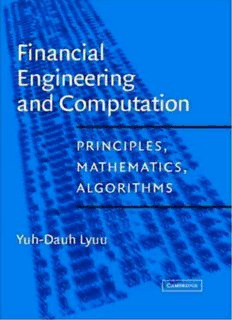Table Of ContentFINANCIAL ENGINEERING AND COMPUTATION
Duringthepastdecademanysophisticatedmathematicaland
computationaltechniqueshavebeendevelopedforanalyzing
financialmarkets.Studentsandprofessionalsintendingtoworkin
anyareaoffinancemustnotonlymasteradvancedconceptsand
mathematicalmodelsbutmustalsolearnhowtoimplementthese
modelscomputationally.Thiscomprehensivetextcombinesa
thoroughtreatmentofthetheoryandmathematicsbehind
financialengineeringwithanemphasisoncomputation,in
keepingwiththewayfinancialengineeringispracticedintoday’s
capitalmarkets.
Unlikemostbooksoninvestments,financialengineering,or
derivativesecurities,thebookstartsfrombasicideasinfinance
andgraduallybuildsupthetheory.Theadvancedmathematical
conceptsneededinmodernfinanceareexplainedataccessible
levels.Thusitoffersathoroughgroundinginthesubjectfor
MBAsinfinance,studentsofengineeringandscienceswhoare
pursuingacareerinfinance,researchersincomputationalfinance,
systemanalysts,andfinancialengineers.
Buildingonthetheory,theauthorpresentsalgorithmsfor
computationaltechniquesinpricing,riskmanagement,and
portfoliomanagement,togetherwithanalysesoftheirefficiency.
Pricingfinancialandderivativesecuritiesisacentralthemeofthe
book.Abroadrangeofinstrumentsistreated:bonds,options,
futures,forwards,interestratederivatives,mortgage-backed
securities,bondswithembeddedoptions,andmore.Each
instrumentistreatedinashort,self-containedchapterforready
referenceuse.
ManyofthesealgorithmsarecodedinJavaasprogramsfor
theWeb,availablefromthebook’shomepage:
www.csie.ntu.edu.tw/∼lyuu/Capitals/capitals.htm.These
programscanbeexecutedonWindows,MacOS,orUnix
platforms.
Yuh-DauhLyuureceivedhisPh.D.incomputersciencefrom
HarvardUniversity.HispastpositionsincludeMemberof
TechnicalStaffatBellLabs,ResearchScientistatNECResearch
Institute(Princeton),andAssistantVicePresidentatCiticorp
Securities(NewYork).HeiscurrentlyProfessorofComputer
ScienceandInformationEngineeringandProfessorofFinance,
NationalTaiwanUniversity.HispreviousbookisInformation
DispersalandParallelComputation.
ProfessorLyuuhaspublishedworksinbothcomputer
scienceandfinance.HealsoholdsaU.S.patent.ProfessorLyuu
receivedseveralawardsforsupervisingoutstandinggraduate
students’theses.
i
FINANCIAL ENGINEERING
AND COMPUTATION
Principles, Mathematics, Algorithms
YUH-DAUH LYUU
NationalTaiwanUniversity
iii
The Pitt Building, Trumpington Street, Cambridge, United Kingdom
The Edinburgh Building, Cambridge CB2 2RU, UK
40 West 20th Street, New York, NY 10011-4211, USA
477 Williamstown Road, Port Melbourne, VIC 3207, Australia
Ruiz de Alarcón 13, 28014 Madrid, Spain
Dock House, The Waterfront, Cape Town 8001, South Africa
http://www.cambridge.org
©Yuh-Dauh Lyuu 2004
First published in printed format 2002
ISBN 0-511-04094-6 eBook (netLibrary)
ISBN 0-521-78171-X hardback
InLovingMemoryof RACHELand JOSHUA
v
Contents
Preface pagexiii
UsefulAbbreviations xvii
1 Introduction 1
1.1 ModernFinance:ABriefHistory 1
1.2 FinancialEngineeringandComputation 1
1.3 FinancialMarkets 2
1.4 ComputerTechnology 4
2 AnalysisofAlgorithms 7
2.1 Complexity 7
2.2 AnalysisofAlgorithms 8
2.3 DescriptionofAlgorithms 9
2.4 SoftwareImplementation 10
3 BasicFinancialMathematics 11
3.1 TimeValueofMoney 11
3.2 Annuities 14
3.3 Amortization 15
3.4 Yields 17
3.5 Bonds 24
4 BondPriceVolatility 32
4.1 PriceVolatility 32
4.2 Duration 34
4.3 Convexity 41
5 TermStructureofInterestRates 45
5.1 Introduction 45
5.2 SpotRates 46
5.3 ExtractingSpotRatesfromYieldCurves 47
5.4 StaticSpread 49
5.5 SpotRateCurveandYieldCurve 50
5.6 ForwardRates 50
5.7 TermStructureTheories 56
5.8 DurationandImmunizationRevisited 60
vii
viii Contents
6 FundamentalStatisticalConcepts 64
6.1 Basics 64
6.2 Regression 69
6.3 Correlation 71
6.4 ParameterEstimation 72
7 OptionBasics 75
7.1 Introduction 75
7.2 Basics 76
7.3 Exchange-TradedOptions 77
7.4 BasicOptionStrategies 78
8 ArbitrageinOptionPricing 84
8.1 TheArbitrageArgument 84
8.2 RelativeOptionPrices 85
8.3 Put–CallParityandItsConsequences 86
8.4 EarlyExerciseofAmericanOptions 88
8.5 ConvexityofOptionPrices 89
8.6 TheOptionPortfolioProperty 90
9 OptionPricingModels 92
9.1 Introduction 92
9.2 TheBinomialOptionPricingModel 93
9.3 TheBlack–ScholesFormula 104
9.4 UsingtheBlack–ScholesFormula 111
9.5 AmericanPutsonaNon-Dividend-Paying
Stock 113
9.6 OptionsonaStockthatPaysDividends 114
9.7 TraversingtheTreeDiagonally 118
10 SensitivityAnalysisofOptions 123
10.1 SensitivityMeasures(“TheGreeks”) 123
10.2 NumericalTechniques 127
11 ExtensionsofOptionsTheory 131
11.1 CorporateSecurities 131
11.2 BarrierOptions 137
11.3 InterestRateCapsandFloors 140
11.4 StockIndexOptions 141
11.5 ForeignExchangeOptions 143
11.6 CompoundOptions 147
11.7 Path-DependentDerivatives 148
12 Forwards,Futures,FuturesOptions,Swaps 155
12.1 Introduction 155
12.2 ForwardContracts 156
12.3 FuturesContracts 161
12.4 FuturesOptionsandForwardOptions 168
12.5 Swaps 173
Contents ix
13 StochasticProcessesandBrownianMotion 177
13.1 StochasticProcesses 177
13.2 Martingales(“FairGames”) 179
13.3 BrownianMotion 183
13.4 BrownianBridge 188
14 Continuous-TimeFinancialMathematics 190
14.1 StochasticIntegrals 190
14.2 ItoProcesses 193
14.3 Applications 197
14.4 FinancialApplications 201
15 Continuous-TimeDerivativesPricing 206
15.1 PartialDifferentialEquations 206
15.2 TheBlack–ScholesDifferentialEquation 207
15.3 Applications 211
15.4 GeneralDerivativesPricing 220
15.5 StochasticVolatility 221
16 Hedging 224
16.1 Introduction 224
16.2 HedgingandFutures 224
16.3 HedgingandOptions 228
17 Trees 234
17.1 PricingBarrierOptionswith
CombinatorialMethods 234
17.2 TrinomialTreeAlgorithms 242
17.3 PricingMultivariateContingentClaims 245
18 NumericalMethods 249
18.1 Finite-DifferenceMethods 249
18.2 MonteCarloSimulation 255
18.3 Quasi–MonteCarloMethods 262
19 MatrixComputation 268
19.1 FundamentalDefinitionsandResults 268
19.2 Least-SquaresProblems 273
19.3 CurveFittingwithSplines 278
20 TimeSeriesAnalysis 284
20.1 Introduction 284
20.2 ConditionalVarianceModelsforPriceVolatility 291
21 InterestRateDerivativeSecurities 295
21.1 InterestRateFuturesandForwards 295
21.2 Fixed-IncomeOptionsandInterestRateOptions 306
21.3 OptionsonInterestRateFutures 310
21.4 InterestRateSwaps 312
Description:During the past decade many sophisticated mathematical and computational techniques have been developed for analyzing financial markets. Students and professionals intending to work in any area of finance must not only master advanced concepts and mathematical models but must also learn how

